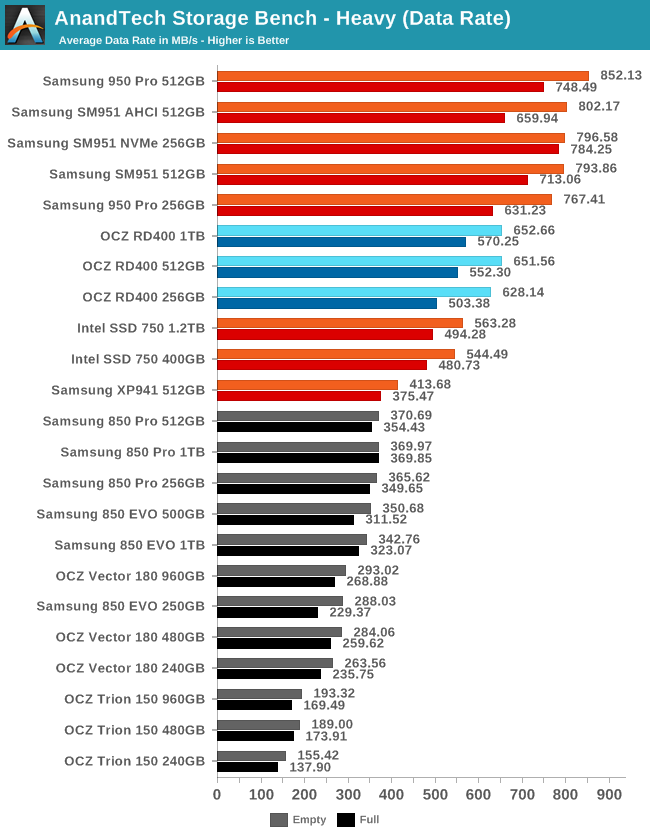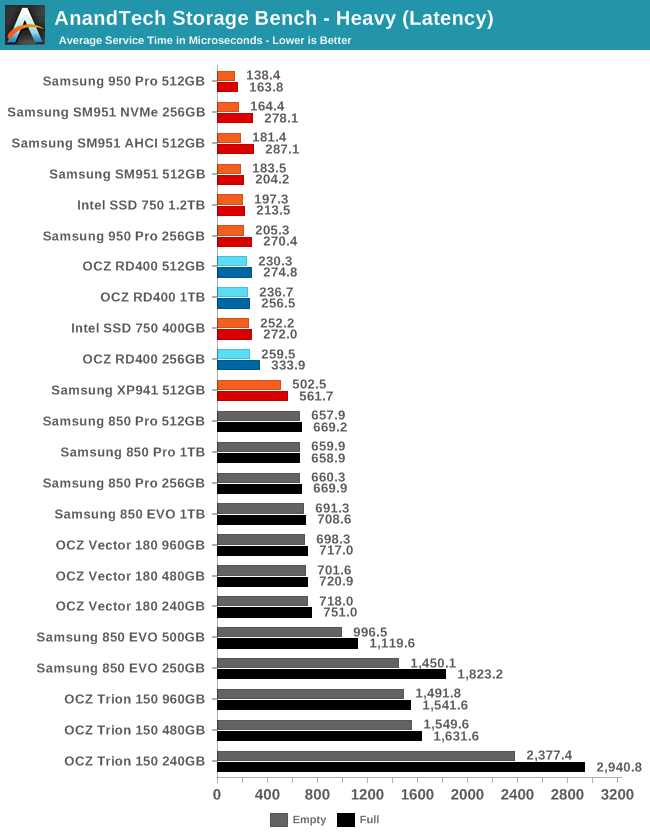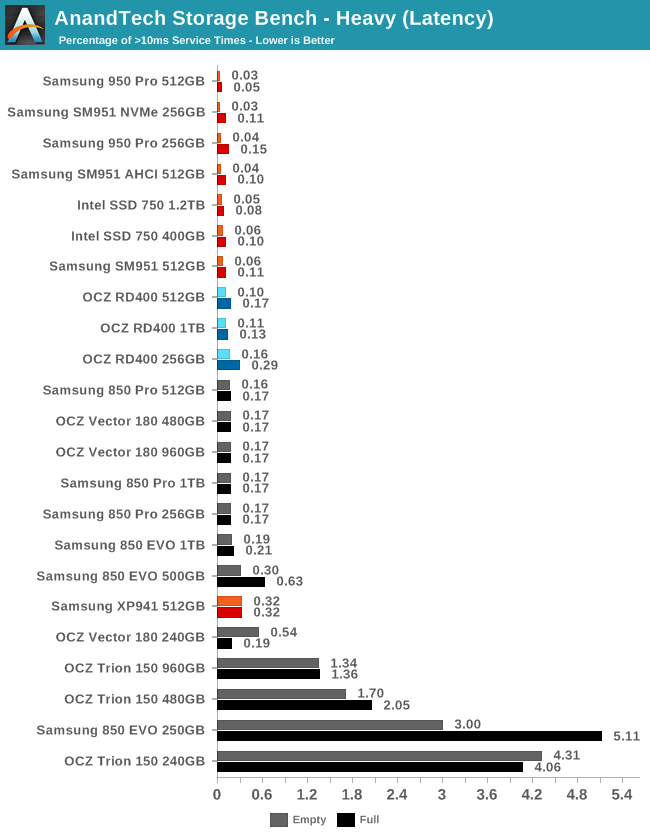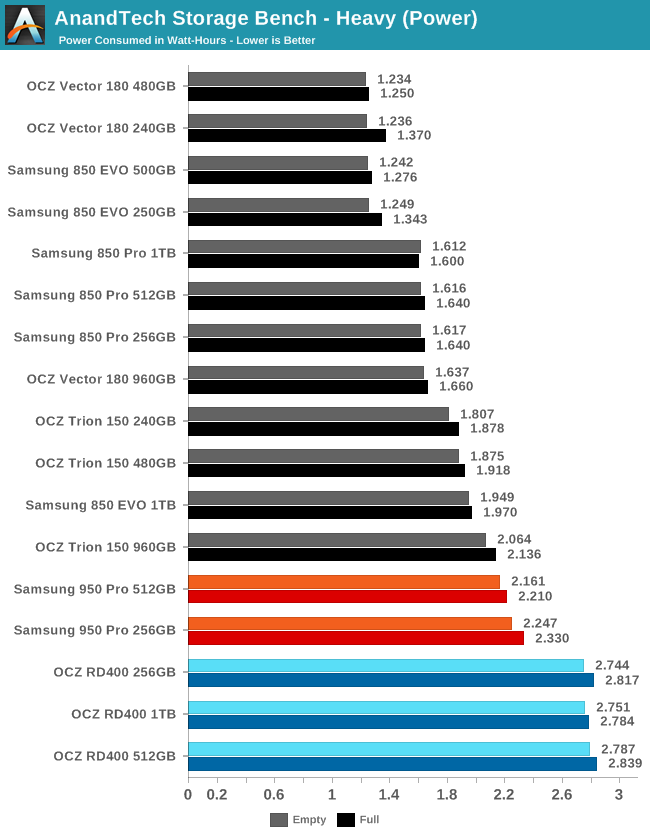The Toshiba OCZ RD400 (256GB, 512GB, 1TB) M.2 PCIe SSD Review
by Billy Tallis on May 25, 2016 8:02 AM ESTAnandTech Storage Bench - Heavy
Our Heavy storage benchmark is proportionally more write-heavy than The Destroyer, but much shorter overall. The total writes in the Heavy test aren't enough to fill the drive, so performance never drops down to steady state. This test is far more representative of a power user's day to day usage, and is heavily influenced by the drive's peak performance. The Heavy workload test details can be found here.

Samsung's PCIe 3 SSDs all clearly outclass the RD400 on the Heavy test, but the RD400 is slightly ahead of the Intel SSD 750 and much faster than everything else.

Average service time on the Heavy test shows clear separation between drive classes. The RD400 is relatively slow for a PCIe 3 SSD, but has less than half the latency of the good SATA drives and is five to ten times better than low-end TLC SATA drives.

The inclusion of a few TLC SATA drives shows how almost everything else handles the Heavy test without being overwhelmed, but the RD400 is also clearly lagging behind the other PCIe 3 drives and the 256GB model needs to perform better when full.

The three capacities of the RD400 all use very similar amounts of energy over the Heavy test, and significantly more than the other drives we've measured.










40 Comments
View All Comments
Meteor2 - Thursday, May 26, 2016 - link
So are we saying NVMe is only really useful for enterprise applications? There just aren't consumer use cases where drive speed is now the limiting performance factor?stux - Thursday, May 26, 2016 - link
This might be the case in Windows, but I've found with OSX, one of the biggest upgrades has been sata3 to PCIe ssd gen 1 to 2 and then 3Ien 0.5 to 1 to 2GB/s
This was evident with all the recent MacBook Pro 15" upgrades and also with PCIe ssds in some Mac Pro towers.
SunnyNW - Wednesday, May 25, 2016 - link
Is the flash controller made on the same memory process or is it made on a separate logic process? I think its made on a separate (logic) process and if so would that be 28nm for most controllers? And is the manufacturing out sourced to TSMC or in-house for most?Ryan Smith - Wednesday, May 25, 2016 - link
Controllers are made on a separate logic process.Kristian Vättö - Thursday, May 26, 2016 - link
The PCIe NVMe controllers are mostly 28nm from what I've heard. SATA controllers can be anything from 40nm to +55nm. Like nearly all logic manufacturing, it's outsourced to TSMC and the like.BangkokTech - Friday, May 27, 2016 - link
Recently got the SM950 pro 512. Large writes slow down after 30 seconds. It starts out ETA 3 minutes, 10 minutes later it's only 70% complete. I read into it; evidently these M.2 cards heat up and slow down. There is absolutely no heatsink on the card. Running them on a PCI expansion card would allow headspace for small heatsinks.BangkokTech - Friday, May 27, 2016 - link
Are any of you aware of a ribbon cable/riser cable I could use to get this M.2 card off my motherboard and move it to a cooler part of my case? I'm out of PCI slots for these expansion cards.Billy Tallis - Saturday, May 28, 2016 - link
Even with the degree of thermal throttling I've observed when not using any kind of heatsink, the 512GB Samsung 950 Pro should only take ~12-13 minutes to fill to capacity with sequential writes. I suspect that your bottleneck is whatever is the source of the data being written, not the 950 Pro.BiTesterEmailer - Wednesday, July 20, 2016 - link
Informative and detailed as always.